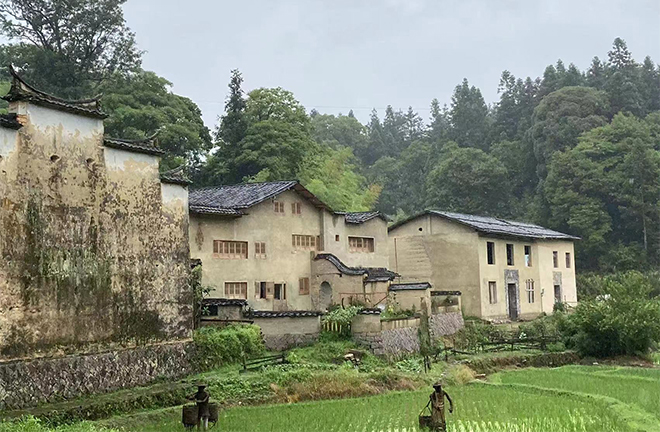Artistic building for rural revitalization

Xiadi village in Pingnan county, Fujian province Photo: PROVIDED TO CSST
How to better play the role of art in the practice of rural revitalization has become a prominent topic of discussion among academics in recent years. As art’s involvement in rural development deepens, contemporary and traditional art have exhibited distinct trajectories in the practice of rural revitalization.
Contemporary art has gradually transitioned from an initial interventionist approach to a more participatory model, while traditional art has also developed rapidly in the model of building local cultural characteristics with the form of intangible cultural heritage (ICH). What are the historical reasons behind the emergence of these two phenomena? What might their future implications be? These questions merit further exploration by the academic community.
Back to rural areas
The Industrial Revolution greatly expanded the scale of cities. With the progress of technology, people and nature are increasingly isolated, and the impact of continuous industrialization on natural ecology is gradually exposed. Sensitive artists realized this problem early on. Following the Industrial Revolution, the Arts and Crafts Movement emerged in Britain from the late 19th century to the early 20th century, subsequently influencing Europe and the United States. While artists are cognizant of the disadvantages of industrial society, they also seek recognition in urban areas, leading to the continual emergence of urban art zones. In China, with the implementation of the rural revitalization across the board, an increasing number of artists and designers have come to the countryside to create.
Participatory artistic rural building
Early interventions of contemporary art in rural revitalization were primarily manifested as artists’ longing for nature and the countryside, evident in the transformation of local cultural spaces and the restoration of traditional buildings. However, unsustainability often characterized rural art construction during this phase.
In the 21st century, contemporary Western participatory art is in full swing, exerting a profound impact on artistic practices in China’s rural areas.
Participatory art emphasizes interaction, cooperation, and dialogue between artists and participants. When applied to the context of rural art development in China, the emphasis on the subjectivity of participants offers a solution to the problem of unsustainability. On the premise of respecting local culture, cooperation and integration with local farmers is a sustainable way for contemporary rural artistic development.
However, addressing the imperative of effectively adapting to China’s specific national conditions and seamlessly integrating into rural construction and development necessitates the urgent resolution of fundamental challenges and the reinforcement of top-level strategic design.
Agricultural & handicraft culture
The countryside contains a wealth of traditional art resources, and in the context of recent efforts in ICH protection and rural revitalization, traditional art—particularly the traditional handicraft industry—assumes a pivotal role.
As early as the 1920s and 1930s, many scholars conducted field research on the role and status of the handicraft industry as a supplementary occupation in China’s rural economy. Their surveys revealed that during the slack season of agricultural production, a significant surplus labor force emerged. While regional variations exist, the surplus labor force typically accounted for more than half of the year’s slack season, transforming farmers from agricultural workers to craftsmen.
The “agricultural and handicraft” cultural gene has historically positioned China as a relatively prosperous agricultural nation. In the contemporary context of ICH protection and rural revitalization, can the “agricultural and handicraft” cultural gene be revitalized and combined with new logistics and network technologies to create a production mode capable of resolving the dilemmas of industrial society?
The Central Rural Work Conference held in December 2017 proposed for the first time the path of socialist rural revitalization with Chinese characteristics, emphasizing the imperative of inheriting, developing, and revitalizing agricultural civilization, and embarking on the path of rural cultural prosperity.
The rapid development of traditional artistic production in rural areas, centered on ICH and the development of local cultural characteristics, embodies the practical implementation of the rural revitalization strategy in the new era.
Fostering ecological civilization
For a long time, Western researchers have regarded the British Industrial Revolution as both the beginning of and model for human modernization, asserting that the economic development model of the United Kingdom and the United States should guide the future modernization of less developed countries.
Reflecting on the fundamental logic behind Chinese economic operation and cultural heritage over millennia, craftsmanship is the genetic essence of our national culture, and rural China has always been the root of Chinese culture.
By combining traditional rural handicrafts with contemporary art, refining the theoretical system of local applied art, and actively exploring the innovation path in line with local agricultural and handicraft cultural genes we can arrive at a new pathway for sustainable human development and the construction of ecological civilization.
An Lizhe is a research fellow from the Institute of Art Studies at the Chinese National Academy of Arts.
Edited by ZHAO YUAN
